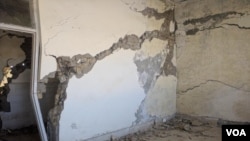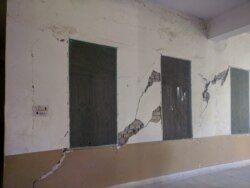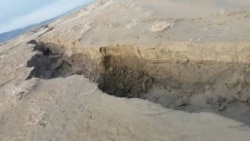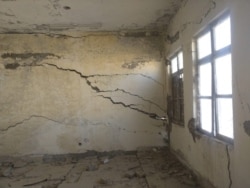Local and American experts warn unchecked groundwater extraction in major urban centers in Pakistan's Baluchistan province has triggered the sinking of the land at a rate of 10 centimeters a year, causing cracks in buildings, roads, and agricultural fields.
The land subsidence is occurring in numerous locations in northern parts of Baluchistan, including districts of Qilla Abdullah, Pishin, Mastung and the provincial capital of Quetta, the largest population center in the province.
The area is arid and groundwater is the only source of water for domestic and agricultural use, said Professor Din Muhammad Kakar of the University of Baluchistan.
"We have drawn a lot of water from the subsurface and the over-exploration of the groundwater has triggered the phenomenon of land subsidence since 2010," said Kakar, who is dean and chairman of the department of seismology.
The collapsing of land has ruptured many old and new buildings in Quetta and other areas, including hospitals and schools.
"There are about a dozen locations in Quetta where cracks as long as four kilometers and more than 400 feet deep have appeared, rendering the land useless for agriculture and living," Kakar said.
The professor said the crisis has stemmed from subsidized power and the absence of strict rules and regulations, which has encouraged people in Baluchistan over the past six decades to drill holes at will and pump the groundwater.
"So, here we don't have any surface water. They [the population] have drilled thousands of boreholes over the past many decades and we have already consumed 12,000 years of that fossil water," Kakar noted.
In the next five to 10 years, he said, there will be no water available to the people in affected districts, including Quetta, and they will have to migrate from this region. The province has also suffered from frequent and prolonged droughts in recent years.
Support from University of Colorado
Kakar said that his university, under a mutual understanding with the University of Colorado in the U.S., has received vital cooperation and equipment, including extensometers and global positioning system (GPS) technology. They have helped Pakistani researchers to precisely measure land subsidence phenomenon and seismic activity across Baluchistan.
"Through that machine we have got the data, which also indicate that these valleys are subsiding at the rate of 10 centimeters per year. The water table is also going down at the rate of three meters per year in these valleys," he noted.
The professor added that daily satellite images taken from space have also verified the results of the GPS and extensometer.
Kakar warned that another earthquake in the areas suffering from land subsidence could be much more devastating than the one that struck Quetta in 1935. That earthquake flattened almost the entire city with an estimated population of 60,000, killing 40,000 people. The current population of the Quetta valley officially stands at around 1.2 million.
Kakar said his department has submitted its report to the provincial government with recommendations on how to address the crisis, but authorities have not taken any action citing lack of financial resources.
"The subsidence process is irreversible. You cannot pump water back into the voids to raise the surface. The underground reservoirs are mostly in the valleys between the mountains of Baluchistan," Professor Roger G. Bilham at the University of Colorado Bolder told VOA.
He noted that the underground water currently being pumped has taken millions of years to accumulate, and is limited in volume. "Millions of years ago, when climates were wetter, many of these valleys sustained lakes. The lakes have long since gone," Bilham said.
Experts say the underground reservoirs consist of sand and gravel layers with water contained in the spaces in between. When the water is pumped to the surface, they say, the sand grains pack together tighter and the thickness of the layer shrinks, and as a consequence, the surface sinks. The results are so extreme, they visible from space.
During heavy rain, flood waters channel into surface cracks caused by land subsidence and widen them further. This process will continue for decades, if not centuries, Bilham said.
Challenges facing authorities
Sparsely populated and poverty-stricken Baluchistan, a natural-resource rich region, is the most underdeveloped province of Pakistan. Authorities for years have faced security challenges in the wake of frequent attacks by anti-state, ethnic Baluch militants and outlawed Islamist groups operating there.
The provincial government spokesman, Liaqat Shawani, told VOA that officials are aware of the land subsidence challenge and efforts are being made to address the issue.
The provincial government had at one stage even imposed a ban on drilling new tube wells in Quetta and other water-stressed areas, he said.
"But people do need drinking water for their survival. Whether or not his home collapses on him or the land is subsiding, the affected person would first do everything possible to provide water for his family, for his children. This is the main issue," Shawani stressed.
The spokesman said the government has to arrange water for the population before imposing restrictions on them, otherwise it could spark a law and order challenge. Shawani added that construction of new dams is under consideration, but such projects would take five or more years to complete.







